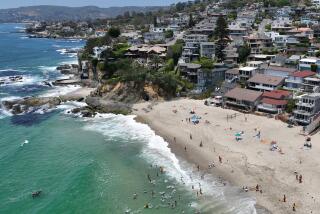War-torn Sierra Leone rebuilds, sacrificing its only protection against sea level rise
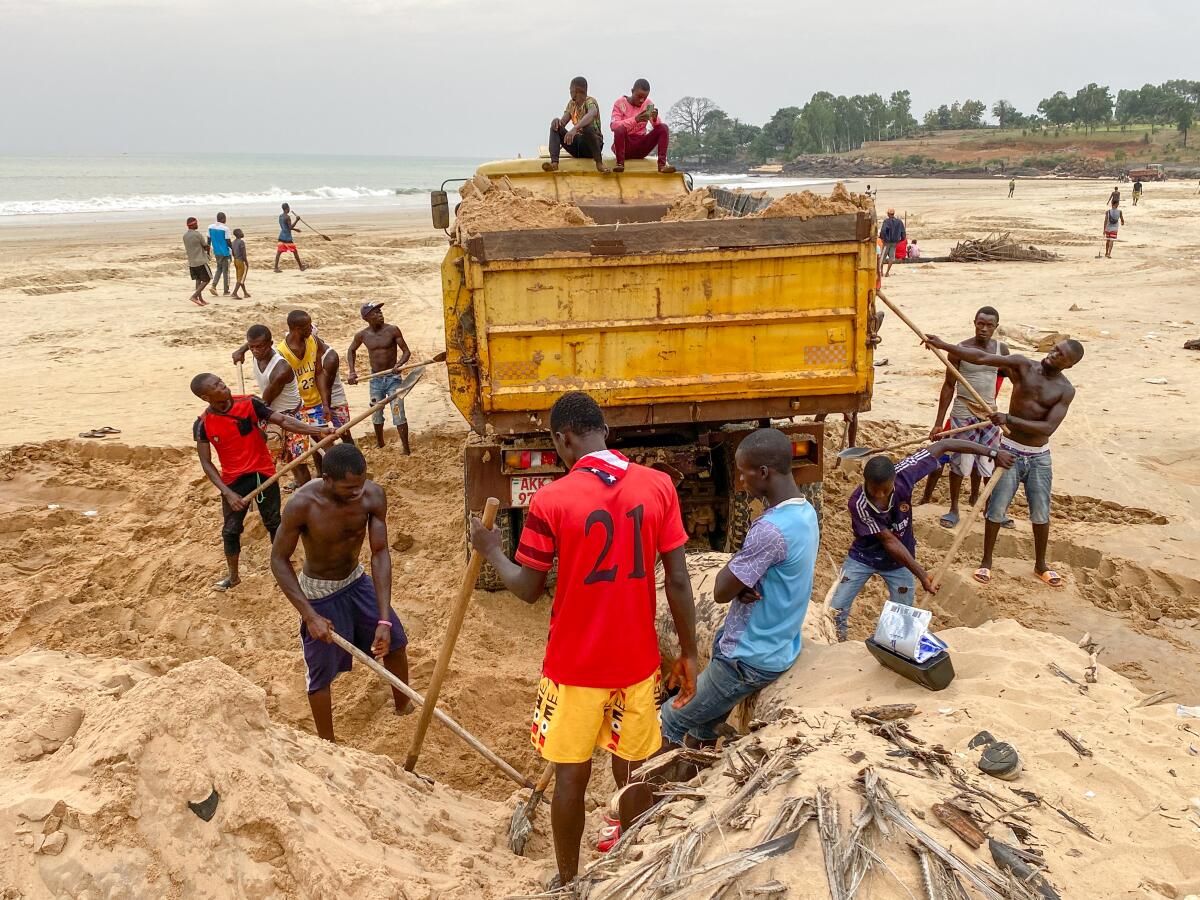
- Share via
JOHN OBEY, Sierra Leone — Each day at sunrise about half a dozen growling dump trucks roll onto the golden sands of this long and narrow beach.
Scores of muscular young men with shovels emerge from the nearby village to begin their work, furiously hurling sand into the trucks.
It takes the laborers — known as sand miners — about half an hour to fill a truck. Then they throw down their shovels and rest as the sand is deposited on a nearby hillside, where it will dry and later be sold to make concrete and glass.
Each truck returns to the beach to be filled again and again.
“Get busy working!” one of the bosses shouts over the roar of the Atlantic as it batters the shoreline.
Sierra Leone’s vast beaches are enabling a construction boom. Two decades after a brutal civil war destroyed much of the country, roads are being paved and extended as houses, hotels and restaurants seem to be going up everywhere.
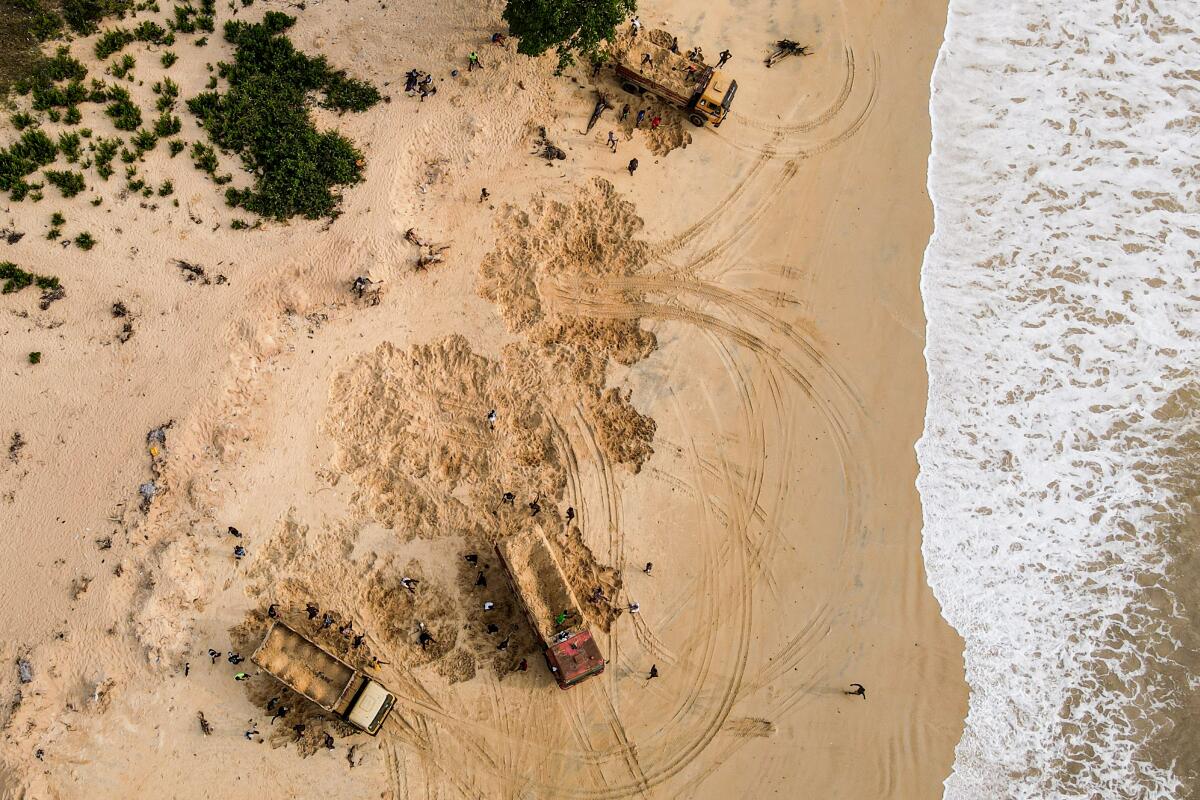
None of it would be possible without sand, a raw ingredient of modern civilization and one of the world’s most important commodities.
But the boundless extraction of sand has come at a steep price: coastal erosion that leaves the country especially vulnerable to rising sea levels caused by climate change.
“The sand has been a buffer,” said Papanie Bai-Sesay, biodiversity officer at the nonprofit Conservation Society of Sierra Leone. “But we are destroying our first line of defense. If we don’t stop, it will be a disaster for millions.”
John Obey Beach is slowly disappearing as the dump trucks haul sand away and the tides push farther inland, toppling trees, destroying beach huts and carving out a yawning cliff of soil where there was once dry, flat land.
Removal of sand changes the wave patterns that transport sand along the coast, so the operation at John Obey Beach is also causing damage a couple of miles south in the surf town of Bureh.
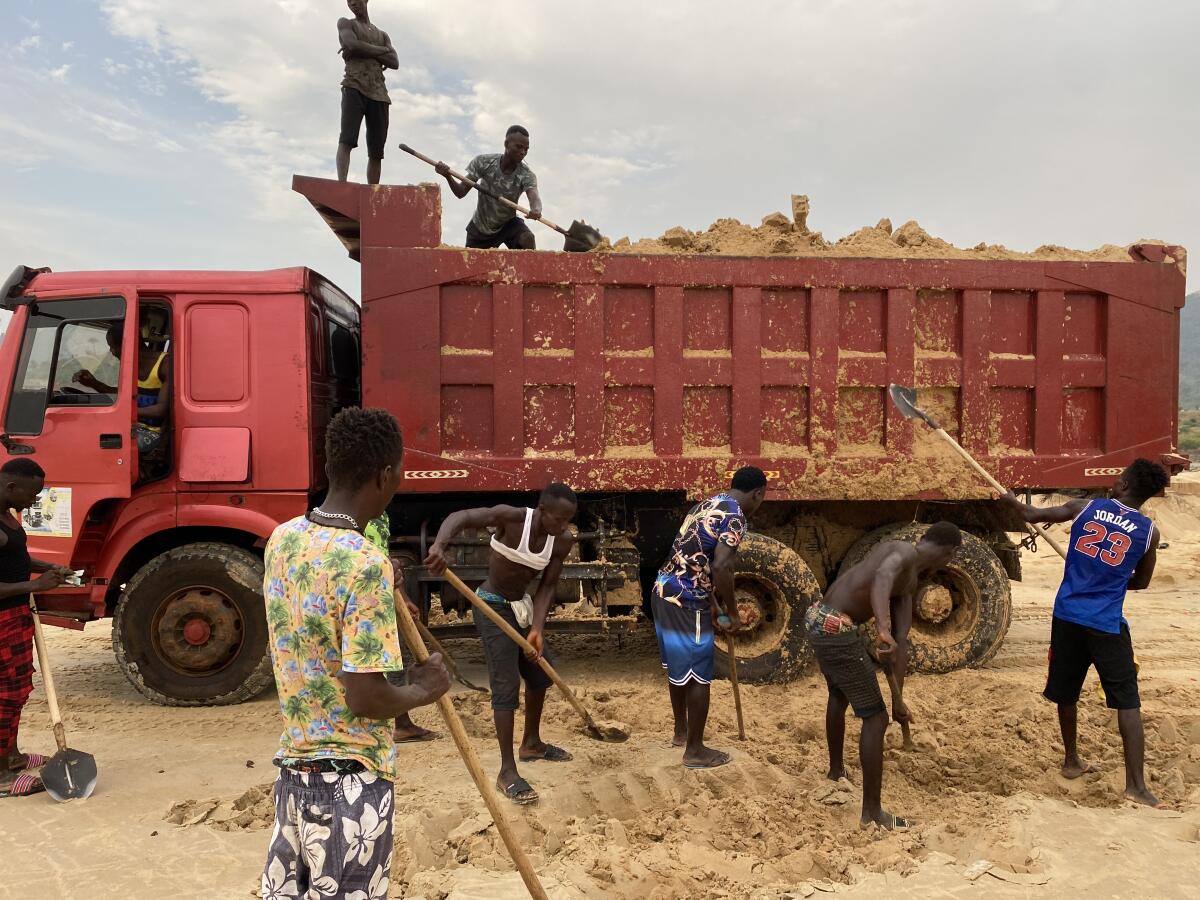
Sand mining has long been illegal there, but several houses and half-built hotels have collapsed into the advancing sea.
Even the surfing in Bureh — one of the most renowned spots in Africa — has suffered, said John Small, a 27-year-old instructor, pointing out the huge rocks that have been exposed as the coastline erodes.
“Ten years ago, you couldn’t see any of them,” he said. “It’s happened so quickly.”
Last year, the ocean flooded Bureh’s waterfront cemetery, washing away several graves. “I saw the bodies,” Small said. “It’s not something you should ever see.”
Christine Cooper, who owns a small hotel on Bureh’s prime beachfront, has been fortifying sea walls in hopes they will offer some protection from the encroaching tides.
“I’ve been piling truckloads of stones in front of them since last year,” she said. “But they will probably collapse in the near future because the sea is constantly rising even more.”
Government officials defend sand mining as an important source of jobs and a necessary step in rebuilding after more than a decade of war that claimed tens of thousands of lives and left the country desperately poor.
The population has nearly doubled since the war ended in 2002, with more than half of the country’s nearly 8 million citizens living in poverty.
But with 300 miles of beaches, Sierra Leone can claim self-sufficiency in sand. Unlike desert sand, which it too fine to use in concrete, beach sand is in high demand worldwide.
“Sand is a great thing,” said Kasho Cole, chairman of the Western Area Rural District Council, which governs most of Sierra Leone’s popular beaches. “We use it to build bridges, roads and houses. It’s important for the livelihoods of people.”
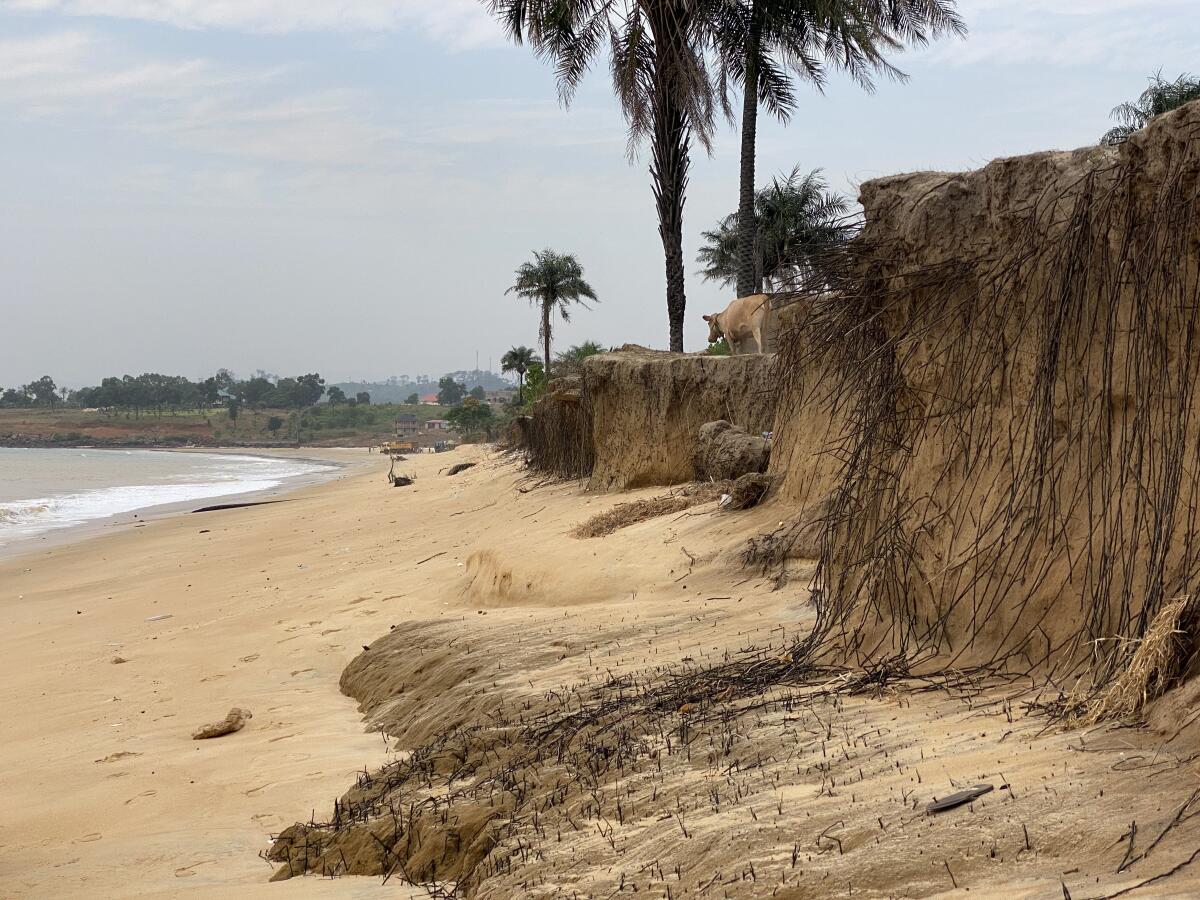
Under the Local Government Act, passed in 2004, the central government handed over regulation of sand mining to local councils as part of a post-civil war move to help communities benefit from local resources.
The councils operate the trucks. Officials say that only locals are permitted to mine sand, which is then sold to developers or anybody else who wants it, with the proceeds going to the council to spend on various community projects.
Cole said his council is sensitive to environmental concerns, having banned sand mining on certain beaches because of the devastation it has already caused.
At the same time, he acknowledged that environmental impact assessments have not been carried out anywhere in his district and that he did not know how much sand was being mined there.
He also said that more needs to be done to stop sand mining in places where it is illegal.
“They do it at night,” he said. “It’s ongoing and we are doing our best to stop it.”
Opponents of sand mining say the industry is prone to corruption.
“The trucks are owned by politicians and they, too, want the money,” said Cooper, who has tried and failed to stop the mining at John Obey Beach.
Paul Lamin, a senior official at the government Environment Protection Agency, said that local councils were using sand to raise revenue on an “ad hoc” basis.
“There’s no accountability or control,” he said. “There aren’t receipts for these transactions.”
Critics also say that indiscriminate mining is sacrificing another economic opportunity: the revival of tourism. Before the war, Sierra Leone’s beaches were popular with adventurous Europeans.
“We have some of the best beaches in Africa and the world,” said Fatmata Abe-Osagie, minister of tourism. “But if something is not done about the mining, these beaches will disappear.”
Alusine Timbo, deputy director of mines at the National Minerals Agency, said that sand should be brought under its purview. Lamin recently introduced a bill in parliament that would toughen requirements for sand mining permits.
The problem is only likely to get worse as sea levels rise. Sierra Leone is particularly vulnerable, with 55% of its population living near the coast.
The seafront in the town of Lakka may offer a glimpse of the future.
Sand mining is illegal there now, but the ban came too late. The beach is little more than a thin wedge of sand lined by rows of crumbling buildings, many now abandoned.
Paul Bangura, a 49-year-old father of nine, said the coastal erosion caused two trees to fall onto his restaurant in August 2019, smashing the roof and knocking down a wall. He had no choice but to shut down for a month and take out a loan for $6,000.
“I’m still fixing the damage,” he said. “If it wasn’t for support from friends, the business would have gone under. This is my life, my future. But the waves are coming closer every day.”
The situation is made worse by sand miners who work at night to evade authorities. Bangura says he knows those involved, but his reports to the police have had no effect.
Back at John Obey Beach, the sand miners continue to fill the trucks, hour after hour, until the burnt orange sun finally begins to set.
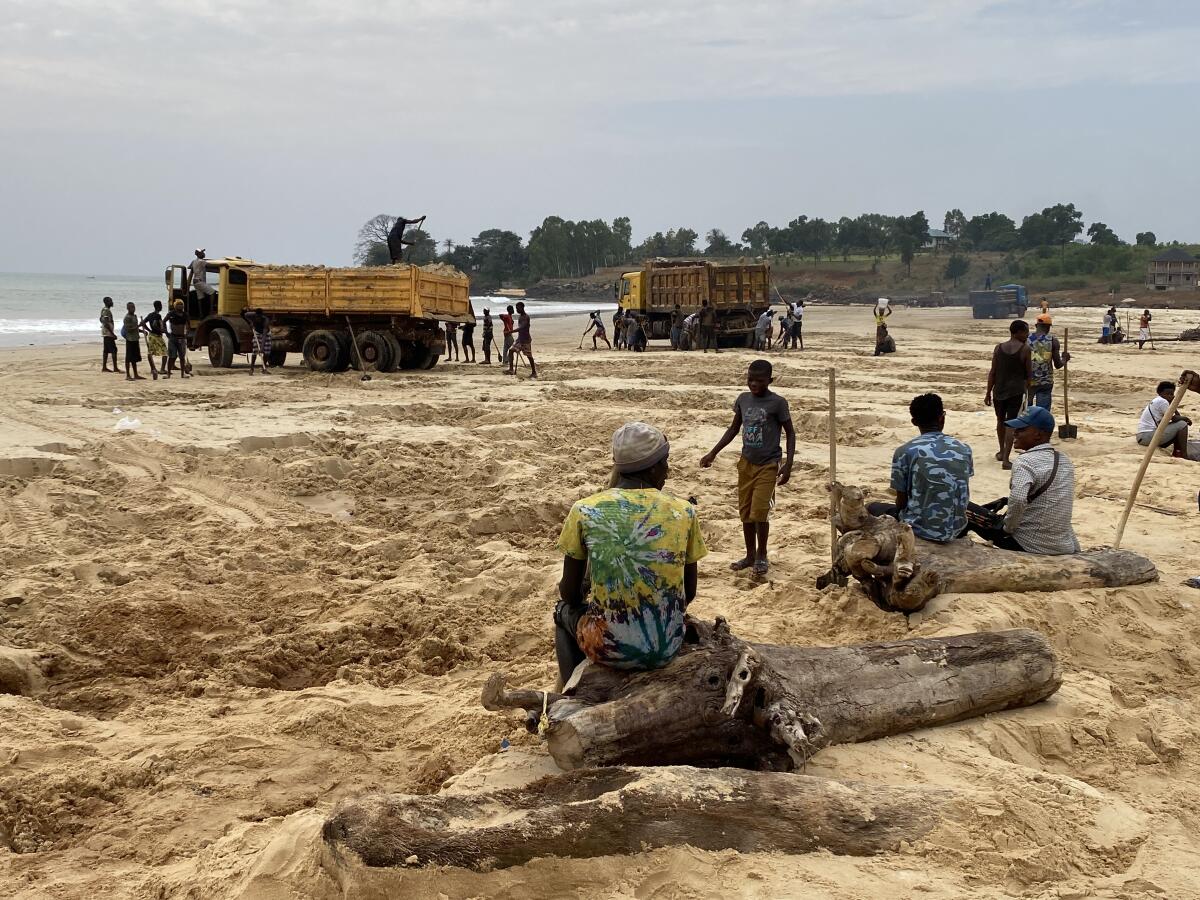
Fatigued from 10 hours of work, several men plop down on the trunks of uprooted trees and snack on fried plantains.
“I don’t want to be here,” said Ousman Korgbo, a 19-year-old miner who earned $5 for the day. “I wish I could go to university and get a real job, but there’s no other choice for me.”
He would be back in the morning.
Peter Yeung is a special correspondent.
More to Read
Sign up for Essential California
The most important California stories and recommendations in your inbox every morning.
You may occasionally receive promotional content from the Los Angeles Times.


